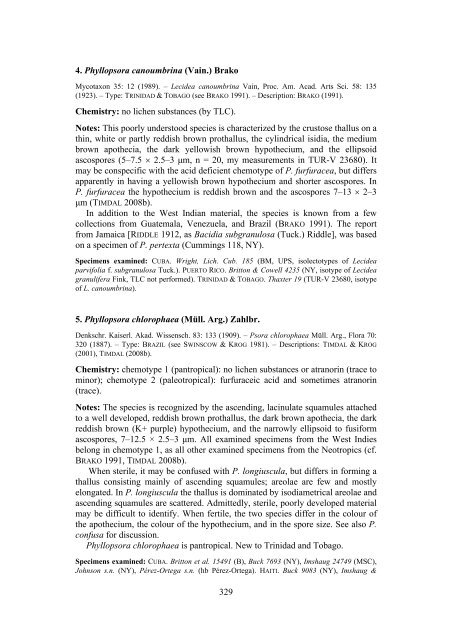A Lichenological Legacy – Festschrift Thomas H
A Lichenological Legacy – Festschrift Thomas H
A Lichenological Legacy – Festschrift Thomas H
Create successful ePaper yourself
Turn your PDF publications into a flip-book with our unique Google optimized e-Paper software.
4. Phyllopsora canoumbrina (Vain.) Brako<br />
Mycotaxon 35: 12 (1989). <strong>–</strong> Lecidea canoumbrina Vain, Proc. Am. Acad. Arts Sci. 58: 135<br />
(1923). <strong>–</strong> Type: TRINIDAD & TOBAGO (see BRAKO 1991). <strong>–</strong> Description: BRAKO (1991).<br />
Chemistry: no lichen substances (by TLC).<br />
Notes: This poorly understood species is characterized by the crustose thallus on a<br />
thin, white or partly reddish brown prothallus, the cylindrical isidia, the medium<br />
brown apothecia, the dark yellowish brown hypothecium, and the ellipsoid<br />
ascospores (5<strong>–</strong>7.5 2.5<strong>–</strong>3 μm, n = 20, my measurements in TUR-V 23680). It<br />
may be conspecific with the acid deficient chemotype of P. furfuracea, but differs<br />
apparently in having a yellowish brown hypothecium and shorter ascospores. In<br />
P. furfuracea the hypothecium is reddish brown and the ascospores 7<strong>–</strong>13 2<strong>–</strong>3<br />
μm (TIMDAL 2008b).<br />
In addition to the West Indian material, the species is known from a few<br />
collections from Guatemala, Venezuela, and Brazil (BRAKO 1991). The report<br />
from Jamaica [RIDDLE 1912, as Bacidia subgranulosa (Tuck.) Riddle], was based<br />
on a specimen of P. pertexta (Cummings 118, NY).<br />
Specimens examined: CUBA. Wright, Lich. Cub. 185 (BM, UPS, isolectotypes of Lecidea<br />
parvifolia f. subgranulosa Tuck.). PUERTO RICO. Britton & Cowell 4235 (NY, isotype of Lecidea<br />
granulifera Fink, TLC not performed). TRINIDAD & TOBAGO. Thaxter 19 (TUR-V 23680, isotype<br />
of L. canoumbrina).<br />
5. Phyllopsora chlorophaea (Müll. Arg.) Zahlbr.<br />
Denkschr. Kaiserl. Akad. Wissensch. 83: 133 (1909). <strong>–</strong> Psora chlorophaea Müll. Arg., Flora 70:<br />
320 (1887). <strong>–</strong> Type: BRAZIL (see SWINSCOW & KROG 1981). <strong>–</strong> Descriptions: TIMDAL & KROG<br />
(2001), TIMDAL (2008b).<br />
Chemistry: chemotype 1 (pantropical): no lichen substances or atranorin (trace to<br />
minor); chemotype 2 (paleotropical): furfuraceic acid and sometimes atranorin<br />
(trace).<br />
Notes: The species is recognized by the ascending, lacinulate squamules attached<br />
to a well developed, reddish brown prothallus, the dark brown apothecia, the dark<br />
reddish brown (K+ purple) hypothecium, and the narrowly ellipsoid to fusiform<br />
ascospores, 7<strong>–</strong>12.5 × 2.5<strong>–</strong>3 μm. All examined specimens from the West Indies<br />
belong in chemotype 1, as all other examined specimens from the Neotropics (cf.<br />
BRAKO 1991, TIMDAL 2008b).<br />
When sterile, it may be confused with P. longiuscula, but differs in forming a<br />
thallus consisting mainly of ascending squamules; areolae are few and mostly<br />
elongated. In P. longiuscula the thallus is dominated by isodiametrical areolae and<br />
ascending squamules are scattered. Admittedly, sterile, poorly developed material<br />
may be difficult to identify. When fertile, the two species differ in the colour of<br />
the apothecium, the colour of the hypothecium, and in the spore size. See also P.<br />
confusa for discussion.<br />
Phyllopsora chlorophaea is pantropical. New to Trinidad and Tobago.<br />
Specimens examined: CUBA. Britton et al. 15491 (B), Buck 7693 (NY), Imshaug 24749 (MSC),<br />
Johnson s.n. (NY), Pérez-Ortega s.n. (hb Pérez-Ortega). HAITI. Buck 9083 (NY), Imshaug &<br />
329<br />
eschweizerbart_xxx

















